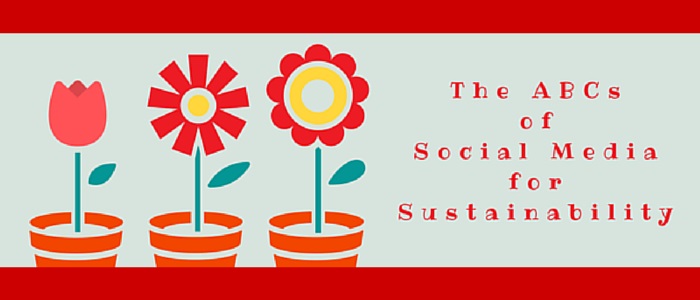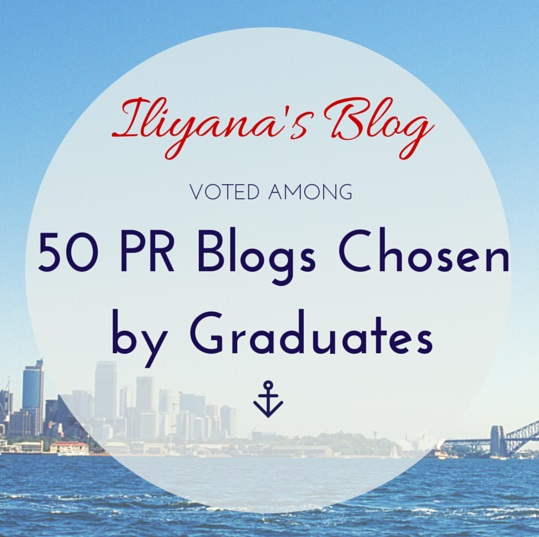
Sustainability... What a difficult word, don't you think? And how about social media?
Can you describe the two in a short sentence? No? You are probably asking: "What does social media have to do with sustainability?"
A lot, actually.
Social media and sustainability are both paradigm shifts. The challenge is how to leverage them and do so in synchrony in order to create business value. Utilising social media could transform any sustainability initiative. And because the foundations of social media and sustainability are guided by the same values of community, transparency, authenticity, innovation and collaboration, combining and aligning the two concepts could have a powerful impact on effectively balancing the triple bottom line.
To help you see the connection, let's go back to school and make things a little bit easier to understand. Below you'll find my list of ABCs with each letter representing an important characteristic that ties these two seemingly unrelated concepts. Additionally, you will find multiple actionable tips you can deploy in your business.
So pay attention now!
The ABCs of Social Media for Sustainability:
A: Authenticity
People like to do business with other people. They like to buy from a real person, not a machine or an organisation. Even more so in sustainability you have to be authentic in your appearance and conversations with individuals because it brings about your personality as a brand, it shows what you stand for. This allows you to demonstrate your values, be transparent and establish trust. Hiding behind organisational doors can only backlash, same with using traditional push marketing methods and manipulative approaches to communications. In the world of social media nothing stays hidden, people can see behind closed doors and they are not afraid to raise their voices. So, don't be vague or use general statements; be honest and authentic and talk about specific actions, features and solutions and offer solid statistics to back up your statements. Be real. On social media authenticity is the name of the game.
B: Brevity
In the era of information overload, you need to adopt a 140 character state of mind. To break out the noise and stand out among the thousands of conversations happening online, you need to make use of various content tools and interactive formats such as text, pictures, infographics, videos, Snapchats, Vines etc. No one has the time and patience to read massive PDF reports. Make your content relevant, short, quick to grasp and understand. The major benefit of making it bite-sized is that it is easy to share so that it can spread. This is how you can leverage the viral power of social and have people talk about you on their own terms.
C: Community
Community-building can be considered a natural result of stakeholder engagement, collaboration and co-creation – all key when we speak about sustainability. Building a strong and robust community is at the centre of any social media campaign too. Social media can bind people from all over the world, with different ideas and understandings, backgrounds and ages, into social groups of individuals with similar interests and desires to improve the quality of life and adopt a sustainable lifestyle. A strong community of engaged fans and followers means that you have true brand ambassadors who not only evangelize your brand and products, but refer them to friends, family and online connections, helping you to generate new customers and convert potential ones. Your fans can also be your biggest advocates and come to the rescue when in crisis. Community can only be win-win.
D: Disclosure
In the world of social media where nothing stays hidden, you need to make your intentions clear. Not only do individuals want the most modern and innovative products, they now increasingly demand corporate consciousness, expecting brands to strike the triple bottom line balance and disclose efforts and results along the way. Full honesty and transparency are key because on social media manipulative approaches or going even further with lies always get found out. Show care, ethical and honest discussion and commitment and you can be sure that you will get this back from your social community too.
E: Engagement
This is the first rule of social media: be there, be available and participate in conversations regularly. It's about having a dialogue. Brands can no longer control the conversation by pushing carefully crafted top-down messages because people find them intrusive and have little trust in them. Social media interactions are relationship builders, they are a crucial part of stakeholder engagement. They show your personality. They allow you to do free research and discover what people like and need. Join, initiate and respond to conversations not only with your customers, but also with your employees. By involving them to share knowledge and ideas, you not only improve performance, motivation and productivity and build trust, but you can also discover tremendous opportunities to develop your brand and products and to align your business with the three Ps – people, planet, profit – to ensure agile long-term sustainable growth.
F: Fun
One thing that is seriously lacking when we speak about sustainability is fun. Sustainability is a difficult and dry topic, ordinary people don't even know what stands behind the term, so why not make it more relevant and easy to understand? Without doubt, there is a requirement to change the currently very technical and preaching-like nature of sustainability communications towards making it more emotional and engaging in order to better reach audiences on a larger scale. There are so many tools you can use to make that happen. Try gamification, create social apps, make some videos, Vines or Snapchats. Being fun, cool, exciting and provocative allows you to be different and communicate your sustainability initiatives in a more meaningful way. Only so will you be able to create powerful change. So, humanise your brand and relax, it’s not rocket surgery. It’s just about thinking from the perspective of your customers, what they need, how they need it, where they need it and why they need it.
G: Greenwashing
We talk about greenwashing when an organisation spends more time and money advertising to be "green" than implementing business practices that actually minimize environmental impact and improve the triple bottom line. Purely stating and sharing socially responsible beliefs and aspirations, especially if these are far from the reality of how a business actually operates, are only going to backlash into a crisis accelerated by the current state of the always-on, always-connected online global village. Companies that try to manipulate public perception through false messages may gain in the short term, but are doomed to fail in the long run with social media only speeding up this menacing process. On social media brands are required to ‘walk the talk’, aligning content with context.
H: Helpful
It has never been easier to help. The web removes constraints. It informs. It educates. It never stops. So, help people make the right choices. Create the right content, share it on social, engage with your communities to educate them and show them how their everyday decisions have a positive or a negative impact on the environment, our planet and our future as a healthy society. Help them understand that we need to change our broken consumption-only lifestyle and embrace a more sustainable culture. Show them "what's in it for me" (WIIFM) – only so will you be able to change perspective and inspire people to create new habits.
I: Innovation
Sustainability cannot exist without innovation. It is innovation that helps us move forward and continually improve living standards. Social media can be your source of innovation. Putting collaboration, crowdsourcing and co-operation at the centre of your social communities allows you to create an innovation catalyst that empowers cultural and social change. Your fans become the change agents who with your help effectively utilise social media as the motor of transformation towards sustainability. Social media can thus be an asset that companies should capitalise on and integrate into their processes, as it can provide competitive advantages and allow brands to become pioneers, sourcing ideas directly from their customers or even co-creating with them.
J: Just
Fairness and honesty are the best policy to build trust. Without trust your business is doomed as no one will buy from you. Especially on social, acknowledge the opinions of others, admit that there are challenges, but show that your company is committed to sustainability in the long run. Make sure you manage expectations and walk the talk. Be just, be fair, admit your mistakes and shortcomings, say you are sorry when you are wrong, show empathy and care. Your customers will relate to this, they will feel cherished, listened to, they will forgive you.
K: Knowledge
For people to adopt a greener lifestyle and buy sustainable products knowledge management is key. They need to know what they are buying, why they are buying it and what the benefits are. To enhance the present and preserve the future companies must play their role in educating society on the devastating risks of unsustainable behaviour and systems failure (e.g. serious loss of biodiversity) in order to mitigate them collaboratively. If society is not made aware of the issues and their extents, then solving them is not possible. There is a need to educate consumers why choosing you and your products it better for them and for our future. They need to know about lifecycle stages, how things are made, sourced and distributed. Knowledge sharing and education are at the centre of social media interactions. WIIFM (“what’s in it for me”) is however key and through social media communications its reach can be multiplied.
L: Listening
The "golden mine" of social media is monitoring conversations and what people are saying about your brand as well as your competitors. So, be attentive to what others are saying. Learn from it. Collect the data. Do the research. Listening and observing allows you to understand what people need and what they might want to change. Integrating such feedback back into the business can be a source of innovation and competitive advantage so that you can design better products and services around emerging needs. What’s more, by actively listening on social media you can guard brand reputation and mitigate damage before it even starts. Companies can quickly and easily understand what their customers care about and respond accordingly.
M: Measurement
Every successful social media and sustainability campaign starts with goals in mind, benchmarks to follow, KPIs to reach and constant measurement to evaluate how much on track you are. You cannot achieve your sustainability goals without measuring along the way, because you cannot make informed decisions without numbers, metrics or quantitative reviews. Without measurement you won’t be able to track if your social media tactics are on track with your KPIs. And in case they are not, you won’t be able to make any changes to ensure the viability of your marketing. You need metrics in order to measure the ROI of your activities and prove the benefits of integrated social media and sustainability campaigns. Measurement is a learning process – track and tweak and then do it better the next time.
N: Now
One of the major benefits (and challenges) of social media is instant feedback and two-way communications. Social media requires consistency, you need to be there 24/7/365 – it's real-time, it's happening now. Patience is a myth. People won't wait. And they express it on social. To effectively get your sustainability messages out there, you need to be able to react quickly to major events or problems as well as to be seen to react quickly to guide public opinion. You no longer have to rely on mediators such as the media, you can simply use your own channels to communicate your messages. The power of owned media is that it is your own to use it whenever you want or need to. Social media makes the now-action possible. Make sure you also listen to what people are saying and monitor you brand’s mentions to correct mistakes and clarify misunderstandings early on before such things have a chance to go viral and backlash.
O: Opportunity
Social still feels like an unchartered territory, especially in the realm of sustainability. This is your opportunity to stand out, to gain a competitive advantage. This is your change not only to increase awareness about your company’s activities and educate society on issues and actions to tackle them, but to collaborate, co-operate and build better products. By actively listening and engaging you can incorporate feedback and take your company's activities to the next level. Involve society to create a better future – this is the opportunity of the century.
P: Planning
You can’t achieve your goals without planning – it’s an essential part of any sustainability and social media strategy. It’s about choosing the right tactics and methods and deciding how to get where you want to be. Without a plan it’s not possible to know where you are going and why you are going there, nonetheless how to get there. Consider all possible avenues and make a detailed plan that describes your daily, weekly and monthly tactics, channels to be used, content to be created, published and distributed. This needs to be well-researched, targeted and actionable and clear on the reason why to do social media. Set your objectives to fit that purpose, develop a robust strategy and plan and be consistent and committed to it. Don’t rush in before you know what you are doing. Otherwise you won’t be able to leverage the power of social media for sustainability.
Q: Quality
Yes, you need to be active 24/7/365, but don’t just do it for the sake of it. Your content needs to be relevant, meaningful, helpful, entertaining and informative. This is more about quality than quantity, not only in terms of your communications, but also the communities that you are building on your social networks. One fan who shares your content is better than 10 who don’t. It’s the quality of the conversations that matter, not the number. It’s about making an impact and communicating effectively rather than just communicating anything because what’s the point in that?
R: Relationships
Social media is just that – social. It's about people connecting with people. And people don’t want to engage with anonymous company representatives – is that even engagement?! The foundation of every relationship is trust. Without trust people won't listen to you, they won’t buy from you. Building trust requires establishing positive, meaningful interactions. It is first and for most about people and relationships. Social media is the perfect avenue to build such relationships and trust around your sustainability authority.
S: Storytelling
Compelling, high-quality content and stories that bring out emotion, encourage action, and evoke change in perception and behaviour is the most powerful tool in your comms arsenal. With so much information available anytime, anywhere, attention is now the main currency. Storytelling gets your brand closer to the individual. By now you now that sustainability is hard to understand and adopt. Through stories shared on social it becomes relevant to 'me' as an individual and to the way I lead 'my life'. It’s no longer about your company being the hero, but about giving your customer the opportunity to become the hero of your stories and your brand. This is how through storytelling you win the battle for attention and inspire sustainable lifestyles.
T: Transparency
Transparency is the fuel of influence. It’s the fuel of trust. It’s the fuel of sustainability progress. It’s the key to successful social media. Transparency is THE principle that guides both social media and sustainability. With transparency social media and sustainability parallel their journey together. It prompts companies to stop hiding behind the true agenda; admit shortcomings, be honest, fair and ready to grow with social co-creation as a driver. The triple bottom line cannot exist without transparency.
U: Ubiquity
Social media allows you to connect everywhere 24/7/365 and grow communities all around the globe. It gives companies the opportunity to conveniently distribute up-to-date and easily accessible information about their sustainability initiatives. This way you are able to better and more quickly reach larger, more mainstream audiences and frequently interact with stakeholders on a personal level to bring down silos and facilitate knowledge sharing. Instead of fearing the lack of information and sharing control as well as freedom of rapid social speech, brands should see this as an opportunity to stand out and demonstrate their progressiveness and willingness to adjust to the new digital world every day with every post.
V: Value
No business can exist in the long run without adding true value to their customers, to the marketplace and to their employees. By leveraging social media for sustainability, companies can gain a distinctive advantage and simultaneously create real business value, because social media is still a major scary challenge for corporates. But organisations must open their eyes and see how it can cause wider sustainability involvement whilst improving the bottom line at the same time. Social media can not only serve as a communications channel, it can go beyond just sharing information to being a collaboration and co-operation tool that can create value and drive real change. Thus, social media can help create a sustainable brand because providing value to stakeholders brings value back to the business.
W: Work
Both social media and sustainability require consistent and persistent effort. You need to understand the nature of social media and that broadcasting doesn't work. Trying to control the conversation and deleting comments and posts by people instead of discussing the issues with them is a no-no. You have to invest in developing your social media skills and presence, because establishing meaningful relationships between humans takes time, patience and hard work. To see results, you need to dedicate enough energy to do it properly. Social media success doesn't happen over night; it takes time to drive conversations, engage and build trust and to see the ROI. Real commitment is required. The same applies to sustainability too. It needs to be integrated within the entire organisation, constantly improved and driven forward. The initial investment is huge, but the long-term benefits are even bigger.
X: X-Ray
On social nothing stays hidden – words have to be aligned with actions. It's this integrity that builds and guards a company reputation. People will put you under the radar – they will "x-ray" you, because they know they have the power. They can raise their voices whenever they want and exponentially increase the reach of their words by leveraging their online networks. The reality is, how consumers and other stakeholders perceive a company today is strongly driven by social media conversations and reviews. Integrity and reputation are the most important assets that you and your organisation have. They are far more important than just profits. Guard them fiercely, because money can be lost and made again, reputation and integrity not so much.
Y: You
Your voice matters. Anyone can be a change agent. Each individual needs to contribute towards a sustainable future. Every tiny action counts and adds up, because change and transformation are nothing but the sum of hundreds of little acts coming together. Embrace consumer-centricity. Acknowledge that in the world of social, it's about them, not your brand. They control your brand. Help people connect to the issues they care about and give them the opportunity to make a difference themselves. Make them your heroes.
Z: Zero waste
Eliminating unnecessary waste throughout the product life cycle is crucial to drive a sustainable future. It not only helps companies to reduce cost and environmental impacts, but also to gain great competitiveness by being pioneers or leaders. Social media engagement and collaboration can show you the way to becoming such a pioneer. Internally, your organisation has the power to do so too. So why not empowering the adoption of social throughout the company – this would lead to efficiencies, added value and zero waste in terms of better allocated efforts. Make zero waste part of your DNA. Inject purpose into every story you tell. Listen to what people are saying, ask them for feedback, involve them, educate them, inspire them. Don’ waste yours and their time, nor yours and their resources.
What's your social media for sustainability alphabet?






